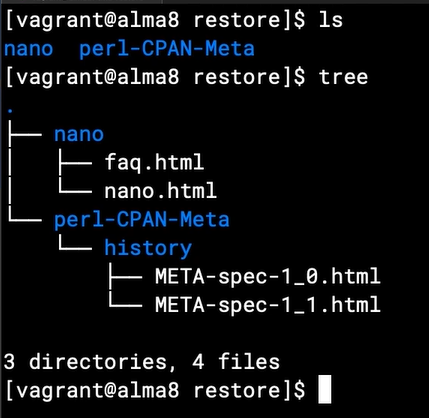Linux Plus-Backing Up and Compressing Files
Objectives
- File Compression Using Compression Tools
- Archiving Using cpio
Creating TAR Files
The command tar can be used to create file archives. Althouth, Tape Archives, they are more commonly used in standard filesystems. By default, a TAR file is not compressed but may appear to be a slightly small size than the original content. This is due to the more efficient use of blocks in the filesystem and not compression
Find the size of our etc directory
- du - disk utilization
- s - summary
- h - human readable
1
2
sudo du -sh /etc
22M /etc
Create archive with a specify the file to back up
- -c - create
1 2 3 4
sudo tar -cf etc.tar /etc tar: Removing leading '/' from member names ls -lh etc.tar -rw-r--r--. 1 root root 21M Jan 18 10:49 etc.tar
Note: The most common block size is 4K on Intel based systems. Each new file goes to a new block potentially wasting space
Tar Operations
- -c - Create
1
tar -cf file.tar file1 file2
- -t - Table of Contents or –verify
1
tar -tf file.tar
- -x - Extract
1
tar -xf file.tar
More Examples
We will investigate the basic tar operations
For summary, look at the disk usage of a directory
1
du -s
or To overcome permission on files
1
2
3
sudo !!
sudo du -sh /etc
23M /etc
1
2
sudo tar -cf etc.tar /etc
tar: Removing leading `/' from member names
To test (verify) the archive,
- -t or –verify
1
sudo tar -tf etc.tar /etc
1
2
ls -lh etc.tar
-rw-r--r--. 1 root root 23M Dec 20 10:08 etc.tar
1
2
ls -l --blick-size=1K etc.tar
-rw-r--r--. 1 root root 22620 Dec 20 10:08 etc.tar
1
2
sudo du -sk /etc
23428 /etc
Various compression utilities exist in Linux
- gzip / gunzip
- bzip2 / bunzip2
- xz -z / xz-d
These can be used independently or with tar
Creating a zipped archive
- tar -czf(gzip)
- tar -cjf (bdip2)
- tar -cJf (xz)
Compression is Independent
Even when using compression options,the tar command is independent of the compression tool that is invoked.
1
2
tar -cJf etc.tar.xz /etc 2>/dev/null&
[1] 5091
- -J - implementing extreme, or xz, compression
- error output - /etc 2>/dev/mull
- & - indicates that backgrounding the task
1
2
3
4
5
6
7
ps
PDI TTY TIME CMD
2831 pts/0 00:00:00 bash
5091 pts/0 00:00:00 tar
5092 pts/0 00:00:01 xz
5093 pts/0 00:00:00 ps
Compression operations from the CLI
Compress from 23MB down to 5.2MB
1
2
3
4
5
6
7
ls -lh etc.tar
rw-r--r--. 1 root root 23M Dec 20 10:08 etc.tar
gzip etc.tar
ls -lh etc.tar.gz
-rw-r--r--. 1 vargrant vagrant 5.2M Dec 20 10:08 etc.tar.gz
To unzip the compressed tar file, etc.tar.gz
1
gunzip etc.tar.gz
To use xz compression,
1
xz etc.tar
1
xz -d etc.tar.xz
Timing Command Operation
Back up and compress in the same time,
To find out how long different compression take to compress a file
1
2
3
4
time tar -cf etc.tar /etc 2>/dev/null
real 0m0.081s
user 0m0.005s
sys 0m0.018s
1
2
3
4
time tar -czf etc.tar.gz /etc 2>/dev/null
real 0m0.745s
user 0m0.719s
sys 0m0.015s
1
2
3
4
time tar -cJf etc.tar.xz /etc 2>/dev/null
real 0m0.630s
user 0m10.390s
sys 0m0.100s
Compressed file size difference
1
2
3
4
ls -lh etc.tar*
-rw-r--r--. 1 vagrant vagrant 22M Dec 20 11:55 etc.tar
-rw-rw-r--. 1 vagrant vagrant 5.2M Dec 20 11:55 etc.tar.gz
-rw-rw-r--. 1 vagrant vagrant 3.2M Dec 20 11:55 etc.tar.xz
Automatic Compression Detection and “Less is More”
1
tar -tf etc.tar.gz
1
2
file etc.tar.gz
etc.tar.gz: gzip compressed data, last modified: Mon Dec20 11:56:01 2021, from Unix, original size 22978560
Display related filename below on compressed archive in pages
1
less etc.tar.gz
To display more metadata of the file use -v option
1
tar -tvf etc.tar.xz
Using CPIO
The command cpio, Copy IO, can be used to create archives. Taking the output from a command to send to an archive to be restored later
Searching a file in a specified directory (shows a full file path)
1
2
3
4
5
find /usr/share.doc -name '*.html'
/user/share/doc/perl-CPAN-Meta/history/META-spec-1_0.html
/user/share/doc/perl-CPAN-Meta/history/META-spec-1_1.html
/user/share/doc/nano/faq.html
/user/share/doc/nano/nano.html
Searching a file in current directory(shows partial file path)
1
2
3
4
5
6
cd /usr/share/doc/
find -name '*.html'
./perl-CPAN-Meta/history/META-spec-1_0.html
./perl-CPAN-Meta/history/META-spec-1_1.html
./nano/faq.html
./nano/nano.html
Searh a file and output the file to a specific location
1
2
find -name '*.html' | cpio -o > /tmp/doc.cpio
246 blocks
- -o - output to
To move the back up file
- -i - import from
- -d - create directory as required
1 2 3
mkdir restore cd restore cpio -id < ../doc.cpio>
Summary
The command tar is used to create a single file archive representing one or more files
The commands gip, bzip2, xz are used to compress files and include options within tar to compress whilst archiving
When compressing with tar options, the compression tool executes independently
Using cpio we take the output of commands to archive and restore using input

